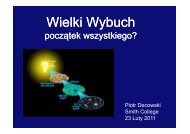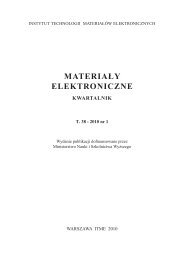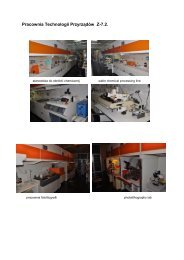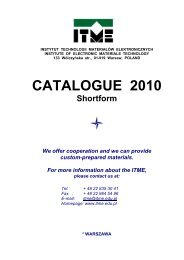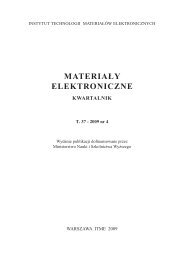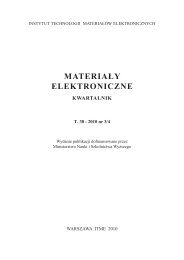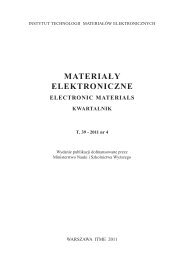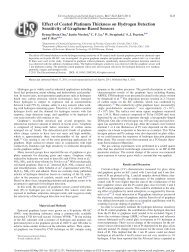MATERIAÅY ELEKTRONICZNE ELECTRONIC MATERIALS ... - ITME
MATERIAÅY ELEKTRONICZNE ELECTRONIC MATERIALS ... - ITME
MATERIAÅY ELEKTRONICZNE ELECTRONIC MATERIALS ... - ITME
You also want an ePaper? Increase the reach of your titles
YUMPU automatically turns print PDFs into web optimized ePapers that Google loves.
Streszczenia wybranych artykułów pracowników <strong>ITME</strong><br />
streszczenia wybranych ARTYKUŁÓW<br />
pracowników itme<br />
Parametric wave interaction in one-dimensional<br />
nonlinear photonic crystal with randomized<br />
distribution of second-order nonlinearity<br />
K. Kalinowski 1,2 , V. Roppo 1,3 , T. Łukasiewicz 4 , M. Świrkowicz<br />
4 , Y. Sheng 1 , W. Krolikowski 1<br />
1<br />
Laser Physics Center, Research School of Physics and<br />
Engineering, Australian National University, Canberra, ACT<br />
0200, Australia<br />
2<br />
Nonlinear Physics Center, Research School of Physics<br />
andEngineering, Australian National University, Canberra,<br />
ACT 0200, Australia<br />
3<br />
Departament de Fisica i Enginyeria Nuclear, Escola Tecnica<br />
Superior d’Enginyeries Industrial y Aeronautica de Terrassa,<br />
Universitat Politecnica de Catalunya, Rambla Sant Nebridi,<br />
08222 Terrassa, Barcelona, Spain<br />
4<br />
Institute of Electronic Materials Technology, Wólczyńska<br />
133,01-919 Warsaw, Poland<br />
Applied Physics B, (2012) 109:557-566<br />
We theoretically study the parametric wave interaction<br />
in nonlinear optical media with randomized<br />
distribution of the quadratic nonlinearity χ (2) . In<br />
particular, we discuss the properties of second and<br />
cascaded third harmonic generation. We derive analytical<br />
formulas describing emission properties of<br />
such harmonics in the presence of χ (2) disorder and<br />
show that the latter process is governed by the characteristics<br />
of the constituent processes, i.e. second<br />
harmonic generation and sum frequency mixing.<br />
We demonstrate the role of randomness on various<br />
second and third harmonic generation regimes such<br />
as Raman–Nath and Cerenkov nonlinear diffraction.<br />
We show that the randomness-induced incoherence in<br />
the wave interaction leads to deterioration of conversion<br />
efficiency and angular spreading of harmonic<br />
generated in the processes relying on transverse<br />
phase matching such as Raman-Nath interaction. On<br />
the other hand, the Cerenkov frequency generation<br />
is basically insensitive to the domain randomness.<br />
Fracture toughness, strength and creep<br />
of transparent ceramics at high temperature<br />
Marek Boniecki, Zdzisław Librant, Anna Wajler, Władysław<br />
Wesołowski, Helena Węglarz<br />
Institute of Electronic Materials Technology, 133 Wólczyńska<br />
Str, 01-919 Warsaw, Poland<br />
Ceramics International, August (2012), 38, 6, , 4517–4524<br />
Fracture toughness, four-point bending strength<br />
of transparent spinel, Y 2<br />
O 3<br />
and YAG ceramics in<br />
function of temperature (from room temperature<br />
up to 1500 °C) were measured. Creep resistance at<br />
1500 – 1550 °C was studied too. Grain size distribution<br />
was determined on polished and etched surfaces<br />
of samples. Fracture surfaces after tests were examined<br />
by scanning electron microscopy. The obtained<br />
results showed that: in the case of spinel ceramics<br />
fracture toughness and strength decreased from 20<br />
to 800° C, increased from 800 to 1200 °C and decreased<br />
at higher temperature; in the case of Y 2<br />
O 3<br />
ceramics they increased from 400 to 800 °C, and<br />
next kept constant up to 1500 °C; in the case of YAG<br />
ceramics they kept constant from 20 to 1200 °C and<br />
then decreased. The creep strain rate was measured<br />
for spinel and YAG but not for Y 2<br />
O 3<br />
ceramics which<br />
appeared creep resistant. The hypotheses concerning<br />
toughening and creep mechanisms were proposed.<br />
Colloidal domain lithography in multilayers<br />
with perpendicular anisotropy: an experimental<br />
study and micromagnetic simulations<br />
Piotr Kuświk 1 , Iosif Sveklo 2 , Bogdan Szymański 1 , Maciej<br />
Urbaniak 1 , Feliks Stobiecki 1 , Arno Ehresmann 3 ,<br />
Dieter Engel 3 , Piotr Mazalski 2 , Andrzej Maziewski 2 ,<br />
Jacek Jagielski 4,5<br />
1<br />
Institute of Molecular Physics, Polish Academy of Sciences,<br />
M. Smoluchowskiego 17, 60-179 Poznań, Poland<br />
2<br />
Laboratory of Magnetism, Faculty of Physics, University<br />
of Białystok, Lipowa 41, 15-424 Białystok, Poland<br />
3<br />
Institute of Physics and Centre for Interdisciplinary Nanostructure<br />
Science and Technology, University of Kassel, Heinrich-Plett-Strasse<br />
40, D-34132 Kassel, Germany<br />
4<br />
Institute of Electronic Materials Technology, Wólczyńska 133,<br />
01-919 Warsw, Poland<br />
78 MATERIAŁY <strong>ELEKTRONICZNE</strong> (Electronic Materials), T. 40, Nr 4/2012




